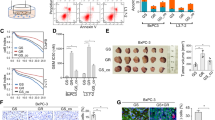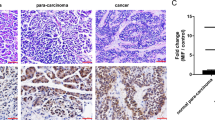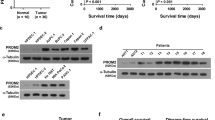Abstract
Pancreatic cancer exhibits profound chemoresistance resulting either from pre-existing (intrinsic) mechanisms, or from anticancer drug treatment itself (acquired chemoresistance). To identify molecular alterations leading to acquired chemoresistance, the chemosensitive pancreatic carcinoma cell line PT45-P1 was exposed to low-dose treatment with etoposide for 6 weeks. Afterwards, these cells (PT45-P1res) were much more resistant to high-dose treatment with anticancer drugs than parental cells. Among several differentially expressed genes in PT45-P1res cells, IL-1β was most significantly upregulated, a finding in line with our previous observation that IL-1β accounts for intrinsic chemoresistance of pancreatic carcinoma cells. Elevated IL-1β expression in PT45-P1res cells was confirmed by real-time PCR and ELISA, and treatment with the IL-1 receptor antagonist restored drug-induced apoptosis. The increased IL-1β secretion was accompanied by an elevated formation of nitric oxide (NO) and a NO-dependent inhibition of the etoposide-induced caspase-3/-7/-8/-9 activity. Caspase activation was restored either by the iNOS inhibitor 1400W, the reducing agent dithiothreitol or the IL-1 receptor antagonist, resulting in greater sensitivity towards anticancer drug treatment. Conversely, IL-1β or the NO-donor SNAP decreased caspase activation and apoptosis in etoposide-treated PT45-P1 cells. These data confirm IL-1β and NO as determinants of chemoresistance in pancreatic cancer, and indicate that the intrinsic and acquired chemoresistance rely to some extent on common molecular targets beneficial for improved therapeutical strategies.
This is a preview of subscription content, access via your institution
Access options
Subscribe to this journal
Receive 50 print issues and online access
$259.00 per year
only $5.18 per issue
Buy this article
- Purchase on Springer Link
- Instant access to full article PDF
Prices may be subject to local taxes which are calculated during checkout






Similar content being viewed by others
Abbreviations
- DTT:
-
Dithiothreitol
- IL-1β:
-
Interleukin 1 beta
- IL1-RA:
-
IL-1 receptor antagonist
- NF-κB:
-
Nuclear factor kappa B
- NO:
-
Nitric oxide
- PDAC:
-
Pancreatic ductal adenocarcinoma
- SNAP:
-
S-Nitroso-N-acetyl-D,L-penicillamine
References
Arlt A, Gehrz A, Müerköster S, Vorndamm J, Kruse M-L, Fölsch UR et al. (2003). Oncogene 22: 3243–3251.
Arlt A, Vorndamm J, Müerköster S, Yu H, Schmidt WE, Fölsch UR et al. (2002). Cancer Res 62: 910–916.
Arlt A, Vorndamm J, Breitenbroich M, Fölsch UR, Kalthoff H, Schmidt WE et al. (2001). Oncogene 20: 859–868.
Banerjee D, Mayer-Kuckuk P, Capiaux G, Budak-Alpdogan T, Gorlick R, Bertino JR . (2002). Biochim. Biophys. Acta 1587: 164–173.
Blaszkowsky L . (1998). Front. Biosci. 3: 214–225.
Bramhal SR, Allum WH, Jones AG, Allwood A, Cummins C, Neoptolemos JP . (1995). Br J Surg 82: 111–115.
Brand RE, Tempero MA . (1998). Curr Opin Oncol 10: 362–366.
Brown JM, Attardi LD . (2005). Nat Rev Cancer 5: 231–237.
Erler JT, Cawthorne CJ, Williams KJ, Koritzinsky M, Wouters BG, Wilson C et al. (2004). Mol Cell Biol 24: 2875–2889.
Friesen C, Fulda S, Debatin KM . (1999). Leukemia 13: 1854–1858.
Jaiswal M, LaRusso NF, Gores GJ . (2001). Am J Physiol Gastrointest Liver Physiol 281: G626–634.
Kalthoff H, Schmiegel W, Roeder C, Kasche D, Schmidt A, Lauer G et al. (1993). Oncogene 8: 289–298.
Kang HC, Kim IJ, Park JH, Shin Y, Ku JL, Jung MS et al. (2004). Clin Cancer Res 10: 272–284.
Kim K-M, Kim PKM, Kwon YG, Bai S-K, Nam W-D, Kim Y-M . (2002). J Biochem Mol Biol 35: 127–133.
Kim R, Emi M, Tanabe K, Toge T . (2004). Cancer 101: 2491–2502. Cancer Res 59: 3505–351.
Kolb JP . (2000). Leukemia 14: 1685–1694.
Li JL, Billiar TR, Talanian RV, Kim YM . (1997). Biochem Biophys Res Commun 240: 419–424.
Lillemore KD . (1998). Surg Oncol Clin North Am 7: 199–216.
Maejima Y, Adachi S, Morikawa K, Ito H, Isobe M . (2005). J Mol Cell Cardiol 38: 163–174.
Medema JP, de Jong J, van Hall T, Melief CJM, Offringa R . (1999). J Exp Med 7: 1033–1038.
Morisaki T, Katano M . (2003). Curr Med Chem 10: 2517–2521.
Müerköster S, Arlt A, Sipos B, Witt M, Großmann M, Klöppel G et al. (2005). Cancer Res F 65: 1316–1324.
Müerköster S, Arlt A, Witt M, Gehrz A, Haye S, March C et al. (2003). Int J Cancer 104: 469–476, 2003.
Müerköster S, Wegehenkel K, Arlt A, Witt M, Sipos B, Kruse ML et al. (2004). Cancer Res 64: 1331–1337.
Neoptolemos JP, Dunn JA, Stocken DD, Almond J, Link K, Beger H et al. (2001). Lancet 358: 1576–1585.
Parker SL, Tong T, Bolden S, Wingo PA . (1997). CA Cancer J Clin 47: 5–27.
Poppenborg H, Knupfer MM, Galla HJ, Ernst J, Wolff A . (1999). Cytokine 11: 689–695.
Schäfer H, Arlt A, Trauzold A, Hünermann-Jansen A, Schmidt WE . (1999). Biochem Biophys Res Commun 262: 139–145.
Schmid RM, Adler G . (2000). Gastroenterology 118: 1208–1228.
Soengas MS, Lowe SW . (2003). Oncogene 22: 3138–3151.
Sreedhar AS, Csermely P . (2004). Pharmacol Ther 101: 227–257.
Stamler JS . (1994). Cell 78: 931–936.
Turzanski J, Grundy M, Russell NH, Pallis M . (2004). Leukemia 18: 1662–1670.
Wang W, Abbruzzese JL, Evans DB, Larry L, Cleary KR, Chiao PJ . (1999). Clin Cancer Res 5: 119–127.
Yan Y, Mahotka C, Heikaus S, Shibita T, Wethkamp N, Liebmann J et al. (2004). Br J Cancer 91: 1349–1357.
Acknowledgements
This work was supported by the German Research Society DFG Scha 677/7-2 (HS).
Author information
Authors and Affiliations
Corresponding author
Rights and permissions
About this article
Cite this article
Müerköster, S., Lust, J., Arlt, A. et al. Acquired chemoresistance in pancreatic carcinoma cells: induced secretion of IL-1β and NO lead to inactivation of caspases. Oncogene 25, 3973–3981 (2006). https://doi.org/10.1038/sj.onc.1209423
Received:
Revised:
Accepted:
Published:
Issue Date:
DOI: https://doi.org/10.1038/sj.onc.1209423
Keywords
This article is cited by
-
First-in-human phase 1 dose-escalation study of CAN04, a first-in-class interleukin-1 receptor accessory protein (IL1RAP) antibody in patients with solid tumours
British Journal of Cancer (2022)
-
Synthesis of interleukin 1 beta and interleukin 6 in human lymphocytes is stimulated by tributyltin
Archives of Toxicology (2018)
-
Exosomes confer chemoresistance to pancreatic cancer cells by promoting ROS detoxification and miR-155-mediated suppression of key gemcitabine-metabolising enzyme, DCK
British Journal of Cancer (2017)



